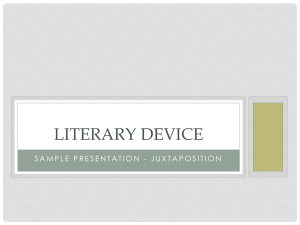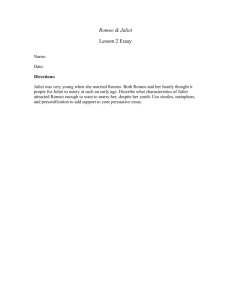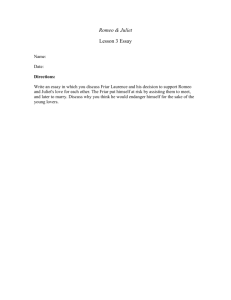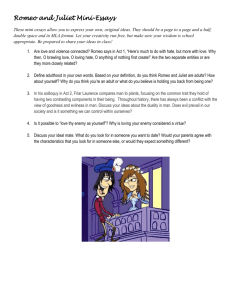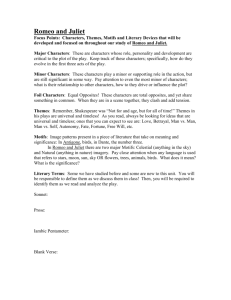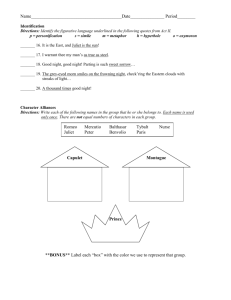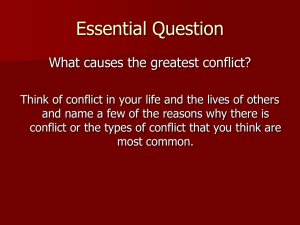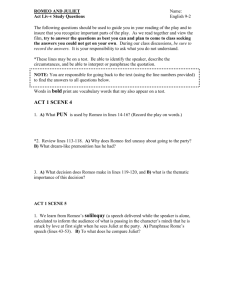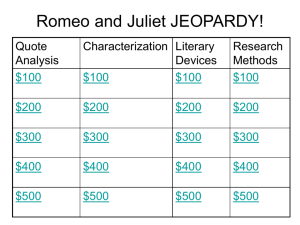Jenny's Literary Terms Chart
advertisement
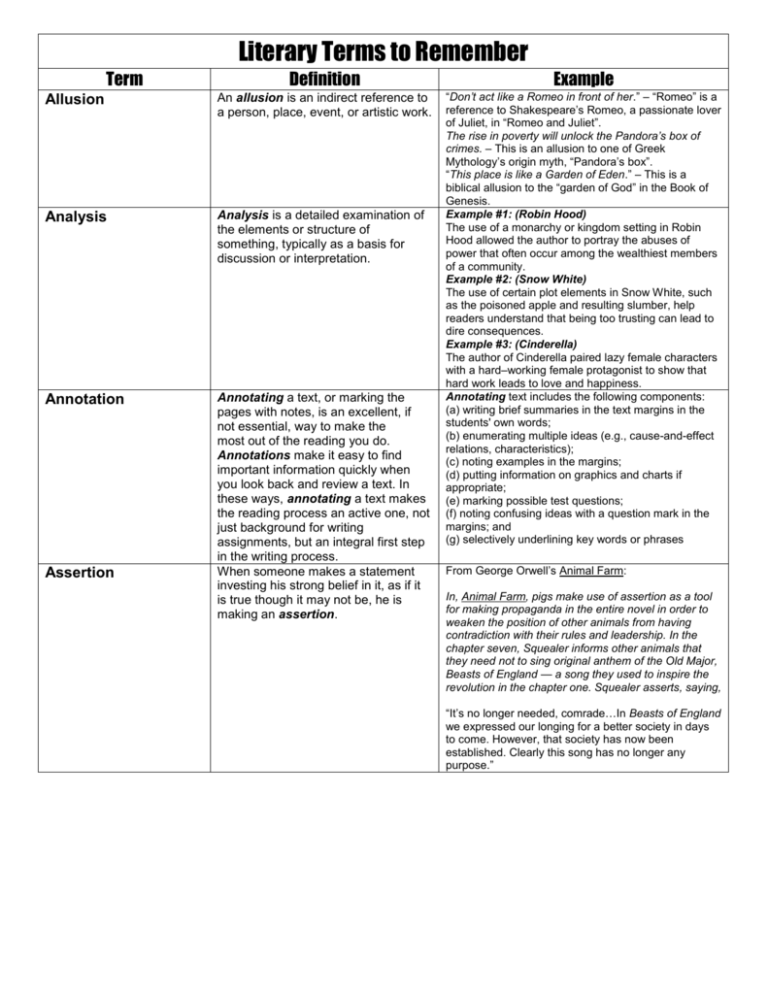
Literary Terms to Remember Definition Example Allusion Term An allusion is an indirect reference to a person, place, event, or artistic work. Analysis Analysis is a detailed examination of the elements or structure of something, typically as a basis for discussion or interpretation. Annotation Annotating a text, or marking the pages with notes, is an excellent, if not essential, way to make the most out of the reading you do. Annotations make it easy to find important information quickly when you look back and review a text. In these ways, annotating a text makes the reading process an active one, not just background for writing assignments, but an integral first step in the writing process. When someone makes a statement investing his strong belief in it, as if it is true though it may not be, he is making an assertion. “Don’t act like a Romeo in front of her.” – “Romeo” is a reference to Shakespeare’s Romeo, a passionate lover of Juliet, in “Romeo and Juliet”. The rise in poverty will unlock the Pandora’s box of crimes. – This is an allusion to one of Greek Mythology’s origin myth, “Pandora’s box”. “This place is like a Garden of Eden.” – This is a biblical allusion to the “garden of God” in the Book of Genesis. Example #1: (Robin Hood) The use of a monarchy or kingdom setting in Robin Hood allowed the author to portray the abuses of power that often occur among the wealthiest members of a community. Example #2: (Snow White) The use of certain plot elements in Snow White, such as the poisoned apple and resulting slumber, help readers understand that being too trusting can lead to dire consequences. Example #3: (Cinderella) The author of Cinderella paired lazy female characters with a hard–working female protagonist to show that hard work leads to love and happiness. Annotating text includes the following components: (a) writing brief summaries in the text margins in the students' own words; (b) enumerating multiple ideas (e.g., cause-and-effect relations, characteristics); (c) noting examples in the margins; (d) putting information on graphics and charts if appropriate; (e) marking possible test questions; (f) noting confusing ideas with a question mark in the margins; and (g) selectively underlining key words or phrases Assertion From George Orwell’s Animal Farm: In, Animal Farm, pigs make use of assertion as a tool for making propaganda in the entire novel in order to weaken the position of other animals from having contradiction with their rules and leadership. In the chapter seven, Squealer informs other animals that they need not to sing original anthem of the Old Major, Beasts of England — a song they used to inspire the revolution in the chapter one. Squealer asserts, saying, “It’s no longer needed, comrade…In Beasts of England we expressed our longing for a better society in days to come. However, that society has now been established. Clearly this song has no longer any purpose.” Characterization is a literary device that is used step by step in literature to highlight and explain the details about a character in a story. Direct characterization takes a direct approach towards building the character. It uses another character, narrator or the protagonist himself to tell the readers or audience about the subject. Indirect characterization is a more subtle way of introducing the character to the audience. The audience has to deduce for themselves the characteristics of the character by observing his/her thought process, behavior, speech, way of talking, appearance, and way of communication with other characters and also by discerning the response of other characters. Here are some examples of direct characterization: 1. Karen is bright, energetic, and helpful. Here, the writer uses adjectives to describe who Karen is as a character. Diction connotation denotation Diction can be defined as style of speaking or writing determined by the choice of words by a speaker or a writer. A connotation is a meaning that is implied by a word apart from the thing which it describes explicitly. A denotation generally defined as literal or dictionary meanings of a word in contrast to its connotative or associated meanings. Generalization A generalization is a general statement or concept obtained by inference from specific cases. Imagery Imagery means to use figurative language to represent objects, actions and ideas in such a way that it appeals to our physical senses. Inference Inference is a literary device used commonly in literature and in daily life where logical deductions are made based on premises assumed to be true. Examples of connotation: A dog connotes shamelessness or an ugly face. A dove implies peace or gentility. Home suggests family, comfort and security. Politician has a negative connotation of wickedness and insincerity while statesperson connotes sincerity. Pushy refers to someone loud-mouthed and irritating. Mom and Dad when used in place of mother and father connote loving parents. Example of denotation: If you search for meaning of the word “dove” in a dictionary, you will see that its meaning is “a type of pigeon, a wild and domesticated bird having a heavy body and short legs.” Examples of generalization: Cats are nicer than dogs. Dogs are smarter than cats. Only a fool would believe what that commercial says. Learning to drive isn’t difficult. College is the only way a person can be properly educated. It was dark and dim in the forest. – The words “dark” and “dim” are visual images. The children were screaming and shouting in the fields. – “Screaming” and “shouting” appeal to our sense of hearing or auditory sense. He whiffed the aroma of brewed coffee. – “whiff” and “aroma” evoke our sense of smell or olfactory sense. Sheldon Cooper: I took another look at the board, and I realized you were right. Raj Koothrappali: So you were wrong. Sheldon Cooper: I’m not saying that. Raj Koothrappali: That’s the only logical inference. Sheldon Cooper: I’m still not saying it. Characterization direct indirect 2. Joe was motivated by money. He had no use for love or family. The sentence above directly states the character of Joe by telling us what motivates him: money. Here is an example of indirect characterization: If a mother calmly tells her son it's time for bed and he responds by saying, 'No, I don't have to do what you say! I'm staying up all night!' then we can infer that this young boy is angry, obstinate and may have authority issues. The author is not telling us directly what kind of personality the little boy has; instead, we must decide this based on the author’s use of speech. (Jim Parsons and Kunal Nayyar, “The Pirate Solution.” The Big Bang Theory, 2009) Juxtaposition Juxtaposition is a literary technique in which two or more ideas, places, characters and their actions are placed side by side in a narrative or a poem for the purpose of developing comparisons and contrasts. Main Idea The main idea is the most important or central thought of a paragraph or larger section of text, which tells the reader what the text is about. Mood In literature, mood is a literary element that evokes certain feelings or vibes in readers through words and descriptions. Paraphrase To paraphrase is to express an idea or somebody’s message in our own words by maintaining the meaning of original material. Juxtaposition is a literary device that William Shakespeare uses most commonly in his play “Romeo and Juliet”. We notice the juxtaposition of “light and “darkness” repeatedly. Consider an example from Act I, Scene V: “O, she doth teach the torches to burn bright! It seems she hangs upon the cheek of night Like a rich jewel in an Ethiope’s ear;” Here, the radiant face of Juliet is juxtaposed with a black African’s dark skin. Romeo admires Juliet by saying that her face seems brighter than brightly lit torches in the hall. He says that at night her face glows like a bright jewel that shines against the dark skin of an African. Example #1: It is often said that lightning never strikes twice in the same place, but this isn’t true. Go ask the forest rangers. Rangers who spend their summers as firefighters will tell you that every thundershower brings several bolts of lightning to their lookout stations. (Notice that the first sentence tells what the paragraph is about; the sentences that follow support the idea stated in the first sentence.) Example #2: Costs were low that year and the output high. There was a good person for each job and the market remained firm. There were no losses from fire. All in all it was the best years in the history of the company. (Note that the first three sentences give details to explain why it was the best year in the company’s history.) Charles Dickens creates a calm and peaceful mood in his novel “Pickwick Papers”: “The river, reflecting the clear blue of the sky, glistened and sparkled as it flowed noiselessly on.” The depiction of idyllic scenery imparts a serene and non-violent mood to the readers. Example #1: Original: Her life spanned years of incredible change for women. Paraphrase: Mary lived through an era of liberating reform for women. Example #2: Original: Giraffes like Acacia leaves and hay and they can consume 75 pounds of food a day. Paraphrase: A giraffe can eat up to 75 pounds of Acacia leaves and hay everyday. Point of View Point of view is the angle of considering things, which shows us the opinion, or feelings of the individuals involved in a situation. In literature, point of view is the mode of narration that an author employs to let the readers “hear” and “see” what takes place in a story, poem, essay etc First Person Point of View: Notice how William Wordsworth uses the first person point of view to express his subjective feelings about the scene of daffodils in his famous poem “Daffodils”. “I gazed–and gazed–but little thought What wealth the show to me had brought.” The use of the pronoun “I” gives a special quality to the feelings expressed in these lines. The reader can see that the poet has employed first person point of view to share with us his own personal emotions. Second Person Point of View: Read the following lines from “Bright Lights, Big City” by Jay Mclnemey: “You are not the kind of guy who would be at a place like this at this time of the morning. But here you are, and you cannot say that the terrain is entirely unfamiliar, although the details are fuzzy.” The writer illustrates the use of second person point of view by using the pronoun “you”. This technique may be a little rare but you can realize that it has its own strength of hooking the reader right from the start. Third Person Point of View: Have a look at the following lines from “Pride and Prejudice” by Jane Austen: “When Jane and Elizabeth were alone, the former, who had been cautious in her praise of Mr. Bingley before, expressed to her sister how very much she admired him.” “He is just what a young man ought to be,” said she, “sensible, good humoured, lively; and I never saw such happy manners! — so much ease, with such perfect good breeding!” Summary A summary is a brief statement or account of the main points of something. Syntax Syntax is a set of rules in a language. It dictates how words from different parts of speech are put together in order to convey a complete thought. Theme Theme is defined as a main idea or an underlying meaning of a literary work that may be stated directly or indirectly. Tone, in written composition, is an attitude of a writer toward a subject or an audience. Tone is generally conveyed through the choice of words or the viewpoint of a writer on a particular subject. Tone These lines demonstrate a fine use of the third person point of view. The excerpt shows the reader two different ways of the use of the third person point of view. Jane Austen first presents two leading characters Jane and Elizabeth, from the third person point of view and then shows us that the two characters are talking about Bingley from their own third person point of view. Summary of Shakespeare’s “Hamlet”: It's the story of a young prince of Denmark who discovers that his uncle and his mother have killed his father, the former king. He plots to get revenge, but in his obsession with revenge he drives his sweetheart to madness and suicide, kills her innocent father, and in the final scene poisons and is poisoned by her brother in a duel, causes his mother's death, and kills the guilty king, his uncle. In casual conversations, we can simply say, “I cannot go out” to convey our inability to go out. P J Kavanagh’s in his poem Beyond Decoration does not rely on merely stating a prosaic “I cannot go out”. Rather, he shifts the syntax and says “Go out I cannot”, which lays a much stronger emphasis on the inability to go out conveyed by the word “cannot”. Examples of various themes: Love and Friendship – as seen in works such as “Romeo and Juliet” or “Frog and Toad are Friends” War – as seen in works like “The Iliad and Odyssey” Example #1: Father: “We are going on a vacation.” Son: “That’s great!!!” – The tone of son’s response is very cheerful. Example #2: Father: “We can’t go on vacation this summer.” Son: “Oh, great! Just what I expected.” – The son’s tone is sarcastic in the given response.
